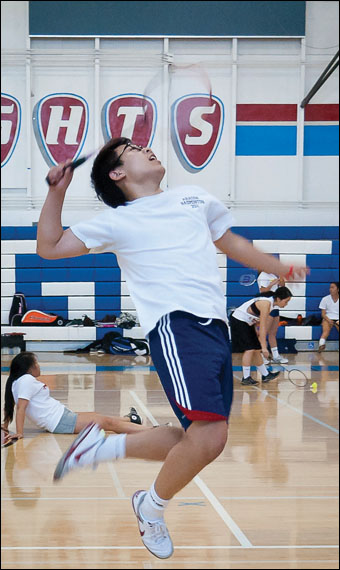

The Aragon badminton team has finished its season undefeated for the second straight year. The team competes in the Peninsula Athletic League Bay Division, and several individuals who competed in the PAL championships will also be moving on to the CCS championships.
The team has quite a few talented players who are looking to do well in the playoffs. Candy Zhang, only a freshman, is one of the stars on the team. Prior to joining the Aragon team, Zhang has placed as high as second place in the 2011 U15 Girls Doubles Junior National and third place in the U15 Girls Doubles Junior International Trial.
Like most sports, strategy is crucial to success. The goal of badminton is to hit a birdie across a net so that the opponent either misses the birdie within the court or is unable to return the birdie without hitting it out of the court. To win a match, junior Alexia Hong says, “I try to think what [my opponents] are thinking and try to hit corners or places where they can’t get it.”
Unlike most sports, however, in badminton, having small stature or large stature does not give an individual leverage or detract from an individual’s ability to perform. Senior Alyssa Lim says “Small people [are] closer to the ground and can move faster. Tall people [are] bigger and can cover more of the court.” Thus, on the court, differing sizes is a matter of trade-offs.
Junior Jaehee Park says that for shorter players, “You can hide behind the net and basically grab anything that the opponents hit near the net. We once had this five foot player [Cindy Lam, who graduated in 2011] that completely dominated at the net.”
Meanwhile, Junior Sam Bunarjo says “I think height gives you an advantage because it’s easier to smash on your opponent.”
On a macro, team scale, badminton operates on a system of points. Each team has three individuals or pairs competing in one of five categories: girl’s singles, girl’s singles, boy’s singles, boy’s doubles, and mixed doubles. In each category, individuals or pairs are ranked by skill level with the “1” seed being the best player of that category in the team. To win a game, a team must win at least eight of the 15 matches.
This system can also be manipulated to secure matches and win more points. Although outright stacking, the act of placing a team’s strongest players in the “2” seed and second strongest players in the “3” seed in order to accrue more points, is banned in league, there are other ways for teams to score safe points. “For PALs, other teams would move their boy’s singles 1 and girl’s singles 1 together as partners to make a mixed team. They take two strong individuals and hope they work well as a team. This strategy usually ensures a win and is not really fair,” says Lim.
Aragon’s badminton team this year has no weak ladders. During the first set of PAL finals an Aragon student or doubles team placed in the top four in each subdivision. Freshmen Candy Zhang placed first in girls singles, senior Emily Yip placed second in girls singles, sophomores Vikki Sun and Vivienne Chen placed second in girls doubles, senior Curtis Ota and freshman Emily Mi placed third in mixed doubles, juniors Sam Bunarjo and Jaehee Park placed fourth in boys doubles and sophomore Sean Gao placed fourth in boys doubles.
Another note is the team’s well rounded strength. During close games, Aragon’s “3” seeds are usually counted upon to win the match winning points. “I definitely think ‘3’s matter in a close game. In fact, I think we were able to win and become league champions because of our ‘3’s,” says Senior Paul Chen.
Moreover, the overall strength of the team is not only seen with regards to “3” seeds. Bunarjo says “we would take exhibition players and put them on varsity a lot of the time if we felt that we would lose those matches. But surprisingly, a lot of our exhibition players have been winning varsity matches.”
During the second set of PAL finals, Zhang and Yip placed first and third in girls singles, respectively, and Vivienne Chen and Vikki Sun placed third in girls doubles. All four students were slated to move on to CCS at the time the Outlook went to print.



